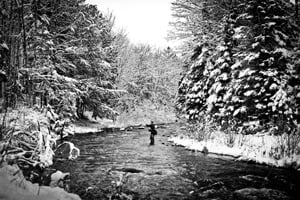Fly Fishing Jazz: Breaking Down the Music

Winter midging. Photo by Kyle Zempel
THE OTHER DAY I was helping my 11-year-old son play “Jingle Bells” on the piano. And it occurred to me that sometimes, the trickiest tunes to learn to play off sheet music are the ones you already hear in your ear, because your mind wants to go in a certain direction, when in fact, the notes are actually telling your fingers to go in another.
I’ve also found that to be true with fly fishing. There’s always more going on than just the melody you hear in your head (in my fly fishing analogy, that’s the cast). Like tone, and tempo, and rhythm are concerns for the musician, the fly angler should be reading water, presenting/drifting the flies just so, while also considering shadows and other factors all the time.
We talk about “what’s most important,” the cast, the drift, etc., in the hypothetical all the time. Well, they’re all important. That’s stating the obvious. Match the hatch perfectly with a good fly, make a pinpoint cast, assure that the fly behaves as naturally as possible after it hits the water, and your odds of hooking fish go up incrementally. Good fly fishing is no more limited to casting than good piano playing is about pushing buttons. Nobody needs a fishing guide or a music teacher to tell them that.
But sometimes, putting it all together at once is as complicated—and ultimately overwhelming—as asking an 11-year old to sight read “Jingle Bells” on the piano, and expecting his left hand, right hand, foot on the pedals, tone, and tempo to all come together.
How do you work through that? Well, in the case of playing the song on the piano, first we focus on that galloping bass melody. Then we work on the right hand part. Then we put them together. Then we start thinking about crescendos and decrescendos. Then we pick up the pace. Practice. Practice. Practice. When something breaks down or doesn’t sound right, we go back and focus on the issue, get that fixed, and then put it all back together.
It should be the same way with fly fishing. You can throw a fly in a coffee cup from 40 feet, but you can’t get bit. Okay, casting isn’t the issue, so let’s break it down, and think about the drift first and foremost. When we’re not dragging the flies, even a little bit, let’s take a closer look at the fly pattern itself. Maybe we’re too big. When in doubt, size down.
The thing is, a good musician can hear his or her mistakes, back up, break it down, polish it up, and put it back together.
The good angler does the same. You’re never going to cast your way through a problem. It’s very unlikely that you can beat fish into submission. Think about all the elements that go into success. Work on them individually. Do mundane things, like practice mending, and you’ll be surprised how well you play when it really matters.











